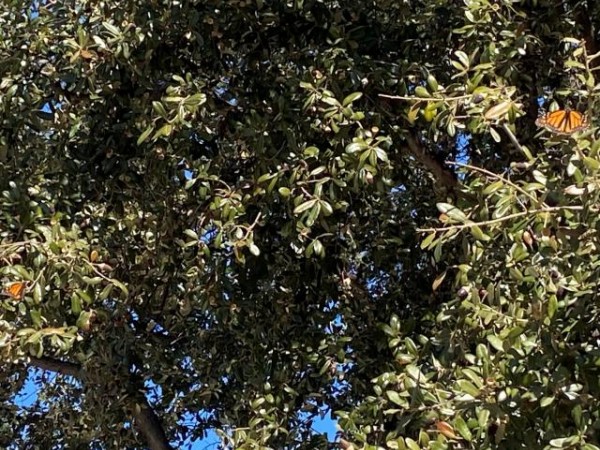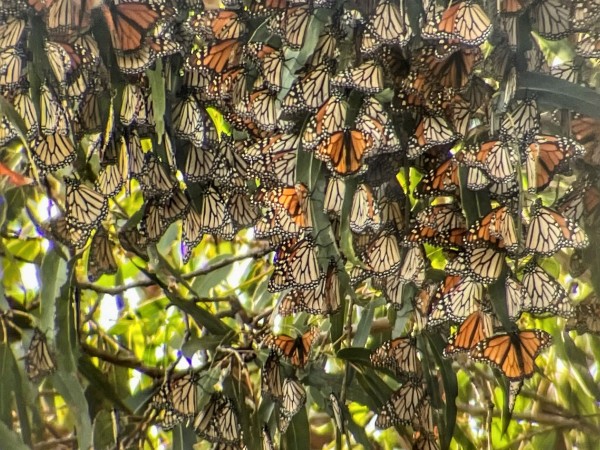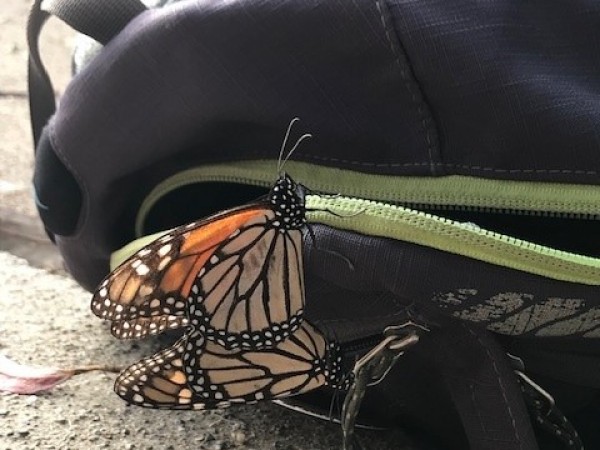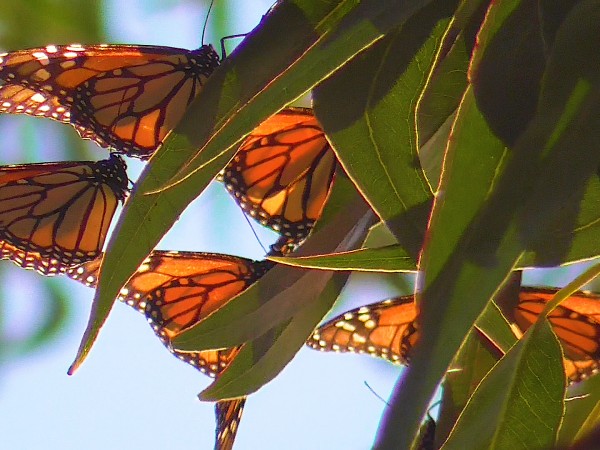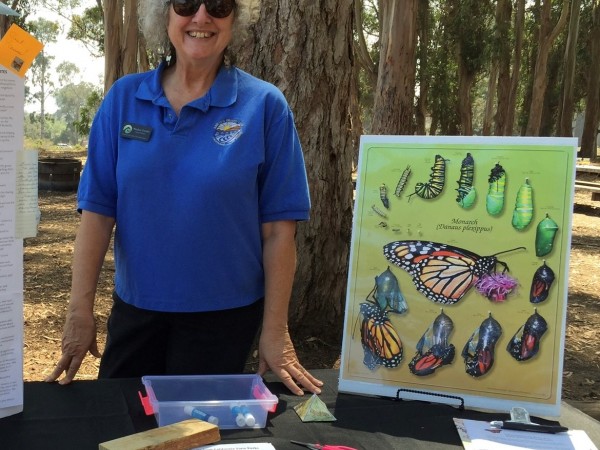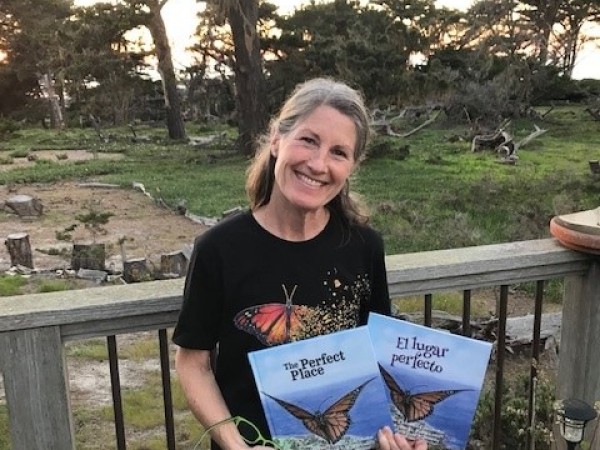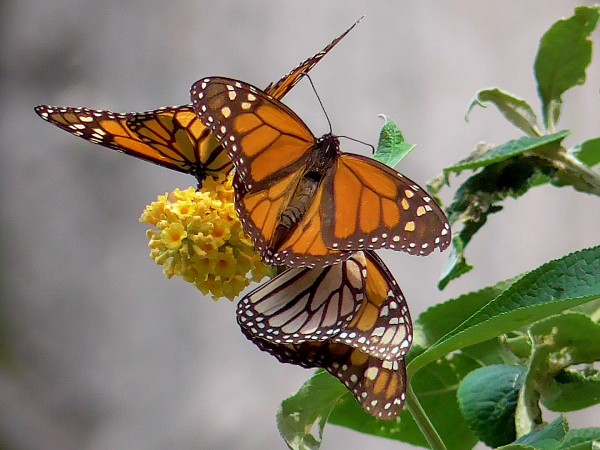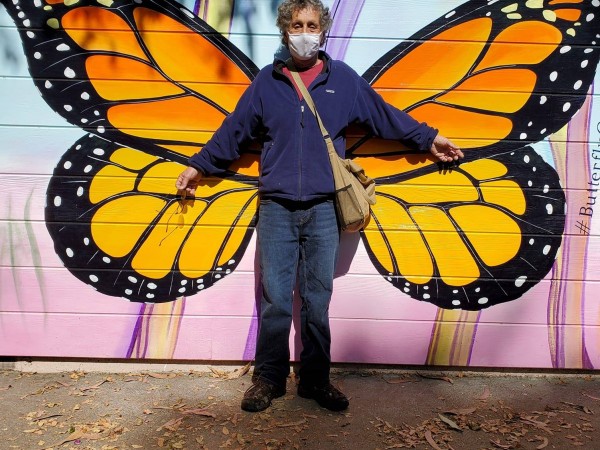Letter from Gail Morris: Western Monarch Winter 2021–22 Report #8
Published: 02/23/2022
Dear Western Monarch Friends,
Monarchs are starting to leave the comfort of the groves throughout the California coast with a few now moving further east than earlier while their mating frenzy continues. Arizona is also reporting monarchs this week. Are milkweeds up and ready for these early migrators to visit? A change in the weather is forecast this week for the region after its active warm spell, so keep your eyes open to monarchs beginning their migration.
Western Monarch Sightings
James in Green Valley, Arizona, found 4 monarchs as part of his weekly monitoring. “Feb. 9, 2022 at La Posada - Central Park, Green Valley, AZ. 1:30 - 3:00 pm, 74 degrees, wind 5 - 10 mph, full sun.
“I observed 4 male Monarchs roaming the garden area and basking in the sun 15 - 20 feet above the ground amongst multiple Live Oak Trees. Photo has 2 males; one at right and left edge.”
On February 12, Patricia, found 3 monarchs in Oxnard, California. “Two females laying eggs, one male.”
Dale in Phoenix, Arizona, saw one monarch on February 13. “Two monarchs flying around about 10:30 to 11:00. I think both were male. At the old butterfly garden - only a few blooms out.” On the same day, Pamela in San Rafael, California, reported, “Two flitting and floating in our backyard.”
On February 17, Scott in Burbank, California saw one monarch. “Flying east about 15 feet above my head.”
Helen in San Francisco, California, spotted two monarchs on February 19. “Flying up Congo towards Monterey.”
Notes from the California Overwintering Sites
Pismo Beach
Marylou Gooden reports smaller clusters and lots of sunning in the monarch population in transition at Pismo Beach. Be sure to see her photos, too, from the 2nd week of February.
“Pismo Monarch Grove is starting to see decreasing numbers of monarchs. In the evenings there are now many small clusters spread throughout the trees. The monarchs moved to the eastern and western areas of the grove with clusters facing open areas instead of in the more protected inner grove. As usual for Valentine’s week, mating is very common.”
Morro Bay
John Barrett reports the monarchs are also leaving Morro Bay National Estuary.
Two weeks ago, John reported, “The great migration has begun. These are among the last of this winter's clusters. Warm weather, frantic eating and very active mating. Arizona tags have been found in this area in past years. Eucalyptus grove along the Morro Bay National Estuary.” This week John shares this update, “There are very few monarchs left in clusters. The warm weather that ended three days ago broke up most of the clusters and signaled the start of their exodus.” Be sure to see John’s photo of the last cluster before the monarch break up.
Pacific Grove
Stephanie Turcotte shares an update about the monarchs at the Butterfly Grove in Pacific Grove.
Cooler temperatures allowed us to count 2,804 monarchs, the morning of February 18th, 2022. The monarchs have once again, changed their positioning in the sanctuary as to be primed and ready for the sun and warming temperatures of the day. They are mostly in the southern portion of the sanctuary, clustered on many of the Eucalyptus trees and very high up. They are also in the neighbor’s yards on the backsides of the same Eucalyptus trees and on a Monterey Pine which has been a favorite roosting spot of monarchs in years past. This south facing side, in the neighbors’ yards, gets a great deal of sun early in the morning and remains sunny throughout the day-therefore there many monarchs are utilizing that area, outside what is considered the PG ‘monarch sanctuary.’ There is also a Monterey Cypress overhanging the adjacent hotel’s fence on the east side of the grove. This tree now also has a few clusters. This tree, too, was utilized in years past by the monarchs at the end of the season-but only at the end.
The sky is a flutter for sure, as the monarchs are actively seeking mates. Pairs are literally falling from the sky onto the visitor paths to carry out the various steps required before they complete their mating in the trees. Docents carry around orange cones to mark the pairs so that visitors may observe safely and don’t accidentally step on them.
As long as the temperatures cooperate and the monarchs remain, we will count them weekly. It’s delightful that so many continue to remain this late in the season.
Be sure to see the photo Stephanie sent, too. “This male was utilizing my backpack last week to gain some height advantage before lifting off with the female, an hour later!
Santa Cruz
Diana Magor updates us about monarchs in the Santa Cruz area.
“John Dayton also counted 15 at LF a couple of days ago. He saw only 5 at Natural Bridges and about 25 at Moran Lake. All males he said, which is normal.
“I still see monarchs in my garden and on daily walks. We believe there is a resident population here, as I have them year round here in Santa Cruz.”
Milkweeds Up in California?
Recently the Bug Squad Blog ran a post about Dr. Art Shapiro, UC Davis distinguished professor of evolution and ecology, reporting the first monarch of the season in West Sacramento. At the time Shapiro said no milkweeds had broken ground yet for this rather early report of a monarch in his area. https://ucanr.edu/blogs/blogcore/postdetail.cfm?postnum=51562
As monarchs leave the safety of the winter groves, there is always a question if milkweeds are up and ready for ovipositing females flying through. Diana Magor shares some good news!
“Milkweeds: Ted Barnecut in Yuba City (51’ elevation in the Valley, N of Sacramento) reported that the Asclepias californica in his garden milkweed plot had started to break ground on Jan 2, 2022! He has 3 plants and all are up now, the 1st one being about 5 cm. This is earlier than usual. There is a correlation between time of first significant rain and emergent date for this species, and I suspect others as well. A. fascicularis is starting to show up in many locations, including as high as at 3,100’ at Midpines, SW of Yosemite, also early. Some say their fascicularis didn’t die back this year. A. eriocarpa is emerging now in the central Sierra foothills, early. No A. cordifolia yet that I have heard of.”
Thanks!
A special Thank You to Marylou Gooden, John Barrett, Diana Magor, Stephanie Turcotte, and Robert Pacelli, for their expanded reports and photographs as well as everyone who submitted sightings and photos this week.
Winter Monarch Sightings Are Important!
Where are monarchs this winter? If you are seeing monarchs, be sure to report to Journey North whether they are adults or eggs or larvae. Provide as much information as you can such as weather conditions (it’s okay to estimate). Your detailed description of what you see can include, but is not limited to, the monarch’s gender and activity and, if known, the type of flowers if they are nectaring. If you can, observe the condition of the wings – are they fresh and new or worn and tattered or something in between – helps us learn more about monarch age and survival. We realize it isn’t always possible, but please take a photo if you can. Thanks so much for your help.
Gail Morris is the Coordinator of the Southwest Monarch Study (www.swmonarchs.org), a Monarch Watch Conservation Specialist, and the Vice President of the Monarch Butterfly Fund, the Central Arizona Butterfly Association and the Western Monarch Advocates. The Western Monarch Population News is based on comments provided to Gail Morris. We hope to increase the number of sightings and therefore photos and comments entered into Journey North. We rely on the volunteers who communicate regularly with Gail and who agree to participate in our effort to increase awareness of the population of western Monarchs. You can reach her at gail@swmonarchs.org

